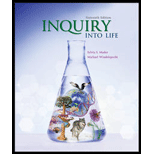
Inquiry Into Life (16th Edition)
16th Edition
ISBN: 9781260231700
Author: Sylvia S. Mader, Michael Windelspecht
Publisher: McGraw Hill Education
expand_more
expand_more
format_list_bulleted
Concept explainers
Question
Chapter 14.4, Problem 1QTC
Summary Introduction
To analyze:
The reason for the removal of quantitative values from various nutrients.
Introduction:
The quantitative nutritional value determines the amount of the nutrient taken in a meal or in a day. The quantitative and quantitative analysis is required for prescribing the different amount of nutrient as per a person’s requirement.
Expert Solution & Answer
Want to see the full answer?
Check out a sample textbook solution
Students have asked these similar questions
What is the structure and function of Eukaryotic cells, including their organelles? How are Eukaryotic cells different than Prokaryotic cells, in terms of evolution which form of the cell might have came first? How do Eukaryotic cells become malignant (cancerous)?
What are the roles of DNA and proteins inside of the cell? What are the building blocks or molecular components of the DNA and proteins? How are proteins produced within the cell? What connection is there between DNA, proteins, and the cell cycle? What is the relationship between DNA, proteins, and Cancer?
Why cells go through various types of cell division and how eukaryotic cells control cell growth through the cell cycle control system?
Chapter 14 Solutions
Inquiry Into Life (16th Edition)
Ch. 14.1 - Prob. 1LOCh. 14.1 - Prob. 2LOCh. 14.1 - Prob. 3LOCh. 14.1 - Prob. 1CYPCh. 14.1 - Compare the major functions of the small intestine...Ch. 14.1 - Discuss strategies that might help obese people...Ch. 14.2 - Summarize the major functions of the pancreas, the...Ch. 14.2 - Prob. 2LOCh. 14.2 - Review what it means to say that the pancreas has...Ch. 14.2 - Prob. 2CYP
Ch. 14.2 - Prob. 3CYPCh. 14.3 - Prob. 1LOCh. 14.3 - Compare the specific types of chemical digestion...Ch. 14.3 - Prob. 1CYPCh. 14.3 - Prob. 2CYPCh. 14.3 - Prob. 3CYPCh. 14.4 - Prob. 1LOCh. 14.4 - Describe the relationship between diet and...Ch. 14.4 - Prob. 3LOCh. 14.4 - Prob. 1QTCCh. 14.4 - Prob. 1CYPCh. 14.4 - Prob. 2CYPCh. 14.4 - Prob. 3CYPCh. 14.4 - Describe how a dietary supplement may be harmful...Ch. 14.5 - Describe the three main categories of eating...Ch. 14.5 - Prob. 2LOCh. 14.5 - Distinguish between compulsive eating, binge...Ch. 14.5 - Prob. 1CYPCh. 14.5 - Predict some physiological factors that could...Ch. 14.6 - Describe a common disorder that affects each part...Ch. 14.6 - Classify the digestive disorders by the type of...Ch. 14.6 - What kinds of adaptations would H. pylori need in...Ch. 14.6 - Why do you suppose that even after Dr. Marshall's...Ch. 14.6 - Prob. 3QTCCh. 14.6 - Identify the specific cause of most stomach...Ch. 14.6 - Explain why the pancreas and liver are such...Ch. 14 - Prob. C2BYBCh. 14 - Chapter 7 By what specific biochemical processes...Ch. 14 - Prob. S11.5BYBCh. 14 - Prob. 1ACh. 14 - Prob. 2ACh. 14 - Prob. 3ACh. 14 - Prob. 4ACh. 14 - Prob. 5ACh. 14 - Prob. 6ACh. 14 - Prob. 7ACh. 14 - Prob. 8ACh. 14 - Prob. 9ACh. 14 - Prob. 10ACh. 14 - Prob. 11ACh. 14 - Prob. 12ACh. 14 - Prob. 13ACh. 14 - Prob. 14ACh. 14 - Prob. 15ACh. 14 - Prob. 16ACh. 14 - Prob. 17ACh. 14 - Prob. 1TCCh. 14 - Suppose you are taking large doses of creatine, an...Ch. 14 - Prob. 3TC
Knowledge Booster
Learn more about
Need a deep-dive on the concept behind this application? Look no further. Learn more about this topic, biology and related others by exploring similar questions and additional content below.Similar questions
- In one paragraph show how atoms and they're structure are related to the structure of dna and proteins. Talk about what atoms are. what they're made of, why chemical bonding is important to DNA?arrow_forwardWhat are the structure and properties of atoms and chemical bonds (especially how they relate to DNA and proteins).arrow_forwardThe Sentinel Cell: Nature’s Answer to Cancer?arrow_forward
- Molecular Biology Question You are working to characterize a novel protein in mice. Analysis shows that high levels of the primary transcript that codes for this protein are found in tissue from the brain, muscle, liver, and pancreas. However, an antibody that recognizes the C-terminal portion of the protein indicates that the protein is present in brain, muscle, and liver, but not in the pancreas. What is the most likely explanation for this result?arrow_forwardMolecular Biology Explain/discuss how “slow stop” and “quick/fast stop” mutants wereused to identify different protein involved in DNA replication in E. coli.arrow_forwardMolecular Biology Question A gene that codes for a protein was removed from a eukaryotic cell and inserted into a prokaryotic cell. Although the gene was successfully transcribed and translated, it produced a different protein than it produced in the eukaryotic cell. What is the most likely explanation?arrow_forward
- Molecular Biology LIST three characteristics of origins of replicationarrow_forwardMolecular Biology Question Please help. Thank you For E coli DNA polymerase III, give the structure and function of the b-clamp sub-complex. Describe how the structure of this sub-complex is important for it’s function.arrow_forwardMolecular Biology LIST three characteristics of DNA Polymerasesarrow_forward
arrow_back_ios
SEE MORE QUESTIONS
arrow_forward_ios
Recommended textbooks for you
- Nutritional Sciences: From Fundamentals to Food, ...Health & NutritionISBN:9781337486415Author:McGuirePublisher:Cengage

Nutritional Sciences: From Fundamentals to Food, ...
Health & Nutrition
ISBN:9781337486415
Author:McGuire
Publisher:Cengage




